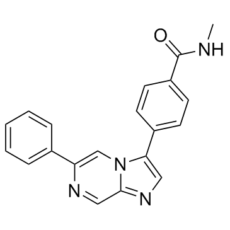AZ32 is a novel, potent and orally bioavailable and blood-brain barrier-penetreable ATM inhibitor (AZ32) that radiosensitizes intracranial gliomas in mice. In an orthotopic mouse glioma model that is syngeneic and human, AZ32 demonstrated superior radiosensitization efficacy in vivo when compared to AZ31. In orthotopic mouse models, AZ32 is the first oral bioavailable ATMi that has been demonstrated to radiosensitize glioma and increase survival. These results lend credence to the creation of a clinical-grade, GBM-treating ATMi that penetrates the BBB. The use of an ATMi in conjunction with conventional radiotherapy is anticipated to be cancer-specific, boost the therapeutic ratio, and preserve the full therapeutic effect at lower radiation doses, which is significant because many GBMs have compromised p53 signalness.
Physicochemical Properties
| Molecular Formula | C20H16N4O | |
| Molecular Weight | 328.38 | |
| Exact Mass | 328.132 | |
| Elemental Analysis | C, 73.15; H, 4.91; N, 17.06; O, 4.87 | |
| CAS # | 2288709-96-4 | |
| Related CAS # |
|
|
| PubChem CID | 134814488 | |
| Appearance | White to off-white solid powder | |
| Density | 1.3±0.1 g/cm3 | |
| Index of Refraction | 1.675 | |
| LogP | 2.22 | |
| Hydrogen Bond Donor Count | 1 | |
| Hydrogen Bond Acceptor Count | 3 | |
| Rotatable Bond Count | 3 | |
| Heavy Atom Count | 25 | |
| Complexity | 457 | |
| Defined Atom Stereocenter Count | 0 | |
| SMILES | O=C(C1C=CC(=CC=1)C1=CN=C2C=NC(C3C=CC=CC=3)=CN12)NC |
|
| InChi Key | LCRTUEXVVKVKBD-UHFFFAOYSA-N | |
| InChi Code | InChI=1S/C20H16N4O/c1-21-20(25)16-9-7-15(8-10-16)18-11-23-19-12-22-17(13-24(18)19)14-5-3-2-4-6-14/h2-13H,1H3,(H,21,25) | |
| Chemical Name | N-methyl-4-(6-phenylimidazo[1,2-a]pyrazin-3-yl)benzamide | |
| Synonyms |
|
|
| HS Tariff Code | 2934.99.9001 | |
| Storage |
Powder-20°C 3 years 4°C 2 years In solvent -80°C 6 months -20°C 1 month |
|
| Shipping Condition | Room temperature (This product is stable at ambient temperature for a few days during ordinary shipping and time spent in Customs) |
Biological Activity
| Targets | ATM ( IC50 = 6.2 nM ); ATM ( IC50 = 0.31 μM ) | ||
| ln Vitro |
|
||
| ln Vivo |
|
||
| Enzyme Assay | AZ32 is a novel type of an ATM inhibitor that can penetrate the blood-brain barrier (BBB). GBM cells were radiosensitized in vitro by AZ32, which also inhibits the DNA damage response. | ||
| Cell Assay | AZ32 (3 μM) and radiation (2 Gy) were applied to human glioma U1242-susceptible cells, or they were not treated. Anti-γ-tubulin (centrosomes) and -α-tubulin (microtubules) were used to fix and process the cells for ICC after 48 hours. To view nuclei, DAPI was used as a counterstain for the cells. | ||
| Animal Protocol |
|
||
| References |
[1]. Orally Bioavailable and Blood-Brain Barrier-Penetrating ATM Inhibitor (AZ32) Radiosensitizes Intracranial Gliomas in Mice. Mol Cancer Ther. 2018 Aug;17(8):1637-1647. |
Solubility Data
| Solubility (In Vitro) |
|
|||
| Solubility (In Vivo) |
Solubility in Formulation 1: ≥ 2.5 mg/mL (7.61 mM) (saturation unknown) in 10% DMSO + 40% PEG300 + 5% Tween80 + 45% Saline (add these co-solvents sequentially from left to right, and one by one), clear solution. For example, if 1 mL of working solution is to be prepared, you can add 100 μL of 25.0 mg/mL clear DMSO stock solution to 400 μL PEG300 and mix evenly; then add 50 μL Tween-80 to the above solution and mix evenly; then add 450 μL normal saline to adjust the volume to 1 mL. Preparation of saline: Dissolve 0.9 g of sodium chloride in 100 mL ddH₂ O to obtain a clear solution. Solubility in Formulation 2: ≥ 2.5 mg/mL (7.61 mM) (saturation unknown) in 10% DMSO + 90% (20% SBE-β-CD in Saline) (add these co-solvents sequentially from left to right, and one by one), clear solution. For example, if 1 mL of working solution is to be prepared, you can add 100 μL of 25.0 mg/mL clear DMSO stock solution to 900 μL of 20% SBE-β-CD physiological saline solution and mix evenly. Preparation of 20% SBE-β-CD in Saline (4°C,1 week): Dissolve 2 g SBE-β-CD in 10 mL saline to obtain a clear solution. Solubility in Formulation 3: ≥ 2.5 mg/mL (7.61 mM) (saturation unknown) in 10% DMSO + 90% Corn Oil (add these co-solvents sequentially from left to right, and one by one), clear solution. For example, if 1 mL of working solution is to be prepared, you can add 100 μL of 25.0 mg/mL clear DMSO stock solution to 900 μL of corn oil and mix evenly. (Please use freshly prepared in vivo formulations for optimal results.) |
| Preparing Stock Solutions | 1 mg | 5 mg | 10 mg | |
| 1 mM | 3.0453 mL | 15.2263 mL | 30.4525 mL | |
| 5 mM | 0.6091 mL | 3.0453 mL | 6.0905 mL | |
| 10 mM | 0.3045 mL | 1.5226 mL | 3.0453 mL |
